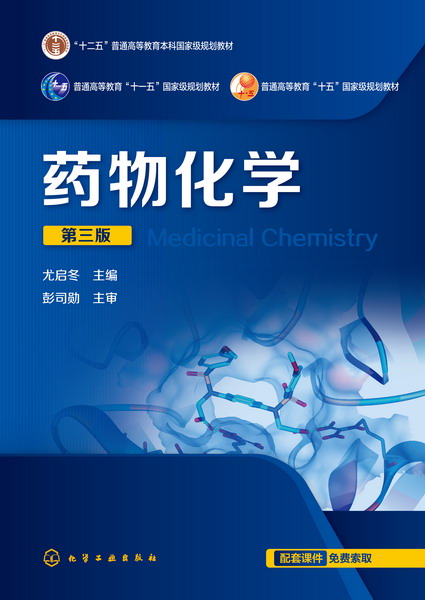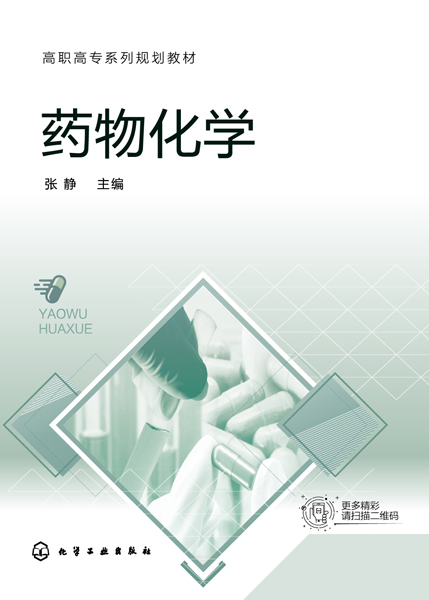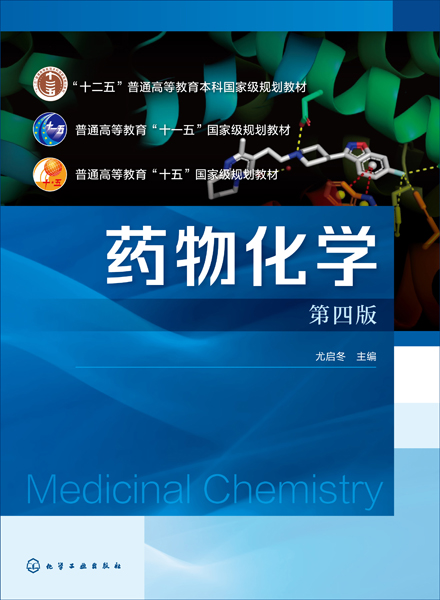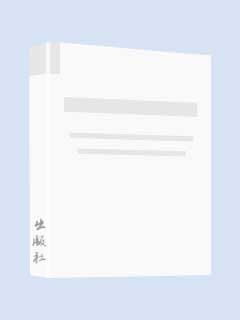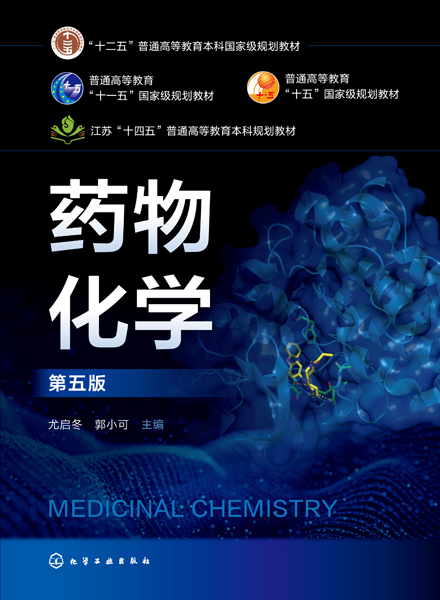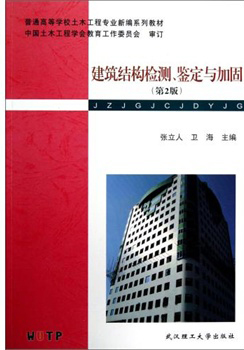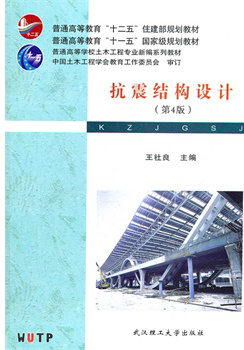药物化学(尤启冬)(第三版)
定价:¥55.00
作者: 尤启冬主编
出版时间:2016-01
出版社:化学工业出版社
普通高等教育“十一五”国家级规划教材“十二五”普通高等教育本科国家级规划教材
- 化学工业出版社
- 9787122248503
- 3版
- 179535
- 46215703-3
- 平装
- 16开
- 2016-01
- 500
- 500
- R914
- 制药、化学等
- 本科
作者简介
内容简介
《药物化学》是教育部普通高等教育“十五”、“十一五”国家级规划教材和“十二五”普通高等教育本科国家级规划教材。
《药物化学》(第三版)删除了第二版中相对比较陈旧的内容,增加一些现代药物化学的新知识点,尤其是近年来新的学科知识,同时对原有的章节进行适当的调整,不仅保留了药物化学课程中各类药物的具体内容,更重要的是,通过前四章内容系统介绍了药物的化学结构所反映的理化性质、结构特征、药物代谢特点与药物活性的关系,即近年来学术界和产业界公认的“构性关系”、“构效关系”和“构代关系”,这是药物的化学本质,也是药物化学的核心所在。
《药物化学》(第三版)以新药研究与开发为主线,结合新药设计、发现和发展过程,介绍新药研究中所使用的方法、原理;介绍各类药物的结构类型、理化性质、构效关系、变化规律以及主要合成路线;并将经典的药物设计方法、QSAR研究与计算机辅助药物设计结合在一起讲解。
《药物化学》(第三版)可供药学类各专业、制药工程专业本科生作为专业课教材使用,也可供相关科研人员学习参考。
《药物化学》(第三版)删除了第二版中相对比较陈旧的内容,增加一些现代药物化学的新知识点,尤其是近年来新的学科知识,同时对原有的章节进行适当的调整,不仅保留了药物化学课程中各类药物的具体内容,更重要的是,通过前四章内容系统介绍了药物的化学结构所反映的理化性质、结构特征、药物代谢特点与药物活性的关系,即近年来学术界和产业界公认的“构性关系”、“构效关系”和“构代关系”,这是药物的化学本质,也是药物化学的核心所在。
《药物化学》(第三版)以新药研究与开发为主线,结合新药设计、发现和发展过程,介绍新药研究中所使用的方法、原理;介绍各类药物的结构类型、理化性质、构效关系、变化规律以及主要合成路线;并将经典的药物设计方法、QSAR研究与计算机辅助药物设计结合在一起讲解。
《药物化学》(第三版)可供药学类各专业、制药工程专业本科生作为专业课教材使用,也可供相关科研人员学习参考。
目录
绪论(Introduction)/ 1
一、药物化学的研究内容和任务(the Scopes and Purpose of Medicinal Chemistry)1
二、药物化学的研究和发展(Research and Development of Medicinal Chemistry)2
三、我国药物化学的发展(Achievements of PRC in Medicinal Chemistry)5
四、新药研究与开发的过程和方法(Process and Methods of New Drug Research and Development)6
选读文献9
第一章药物结构与生物活性(Structure-Activity Relationships of Drugs)/ 10
第一节药物理化性质对药物活性的影响(Affection of Physical and Chemical Properties of Drugs on Pharmacologic Activity)11
一、药物结构与理化性质(Chemical Structure and Physico-Chemical Properties of Drugs)11
二、药物的亲脂性和药物活性(Lipophilic Properties and Pharmacological Activities of Drugs)12
三、药物的pKa和药物活性(pKa and Pharmacological Activities of Drugs)13
四、药物溶解度与药物活性(Solubility and Pharmacological Activities of Drugs)14
五、药物结构与药物透膜性(Chemical Structure and Permeability of Drugs)17
第二节药物的结构对药物活性的影响(Affection of Drug Structure on Pharmacological Activities)18
一、药物与受体的键合作用(Binding of Drugs on Receptor)19
二、药物的各官能团对药效的影响(Affection of Functional Groups of Drugs on Pharmacological Activities)20
三、药物电荷分布对药效的影响(Affection of Charge Distribution of Drugs on Pharmacological Activities)22
四、药物的立体异构体对药效的影响(Affection of Stereoisomers of Drugs on Pharmacological Activities)22
第三节药物结构对药物转运的影响(Affection of Drug Structure on Transportation)25
一、药物化学结构对膜转运的影响(Affection of Drug Structure on Membrane Transportation)25
二、药物化学结构对血脑屏障透过性的影响(Affection of Drug Structure on Blood-Brain Barrier Penetration)27
第四节药物结构对药物毒副作用的影响(Affection of Drug Structure on Side Effects and Toxicities)28
一、药物对细胞色素P450的作用(Action of Drugs on Cytochrome P450)28
二、药物对心脏快速延迟整流钾离子通道(hERG)的影响(Affection of Drugs on hERG)29
选读文献32
第二章药物结构与代谢(Structure-Metabolics Relationships of Drugs)/ 33
第一节官能团化反应(Functionalization Reactions)33
一、氧化反应(Oxidation)34
二、还原反应(Reduction)42
三、水解反应(Hydrolysis)42
第二节结合反应(Conjugation Reactions)43
一、葡萄糖醛酸结合(Glucuronic Acid Conjugation)44
二、硫酸结合(Sulfate Conjugation)45
三、氨基酸结合(Conjugation with Amino Acids)46
四、谷胱甘肽或巯基尿酸结合(Glutathione or Mercapturic Acid Conjugation)47
五、乙酰化结合(Acetylation)49
六、甲基化结合(Methylation)50
第三节药物代谢研究在药物开发中的应用(Application of Drug Metabolism Research in Drug Development)51
选读文献54
第三章药物设计的基本原理和方法(Basic Principles of Drug Design)/ 55
第一节先导化合物发现的方法和途径(Approaches for Lead Discovery)55
一、从天然产物活性成分中发现先导化合物 (From Bioactive Component of Natural Resources)56
二、通过从分子生物学途径发现先导化合物 (From Molecular Biology Research)58
三、通过随机机遇发现先导化合物(From Accidental Discovery)59
四、从代谢产物中发现先导化合物(From Metabolites)60
五、通过从临床药物的副作用或者老药新用途中发现新药(From Side-Effect or New Purpose of Medicine)60
六、从药物合成的中间体中发现先导化合物(From Synthetic Intermediates)61
七、通过计算机辅助药物筛选寻找先导化合物(By Screening of Compound Databases)62
八、通过其他的方法得到先导化合物(Other Methods)63
第二节先导化合物的优化(Lead Optimization)64
一、烷基链或环的结构改造(Alterations of Compound with Alkyl or Ring)64
二、生物电子等排(Bioisosteres)66
三、前药原理 (Prodrug Principle)70
四、软药(Soft Drug)74
五、硬药(Hard Drug)74
六、孪药(Twin Drug)75
第三节定量构效关系(Quantitative Structure-Activity Relationships)76
一、疏水性参数(Lipophilicity Parameters)77
二、电性参数(Electronic Parameters)78
三、立体参数(Steric Parameters)78
四、Hansch方法在药物设计中的应用(Hansch Method Using on Drug Design)78
第四节计算机辅助药物设计(Computer-Aided Drug Design)80
一、基于受体结构的药物设计(Receptor-Structure-Based Drug Design)80
二、基于小分子的药物设计(Molecular-Based Drug Design)82
选读文献85
第四章镇静催眠药和抗癫痫药(Sedative-Hypnotics and Antiepileptics)/ 86
第一节镇静催眠药(Sedative-Hypnotics)86
一、镇静催眠药的发展及分类(Development and Classification of Sedative-Hypnotics)86
二、镇静催眠药的作用靶标及作用机制(Target and Mechanism of Action)87
三、苯二氮类催眠镇静药(Sedative-Hypnotics of Benzodiazepines)89
四、非苯二氮类GABAA受体激动剂(Nonbenzodiazepine GABAA Agonists)96
五、褪黑素受体激动剂(Melatonin Receptor Agonists)98
第二节抗癫痫药(Antiepileptics)99
一、巴比妥类药物(Barbiturates)100
二、巴比妥类的同型药物(Homotypical Drugs of Barbiturates)103
三、二苯并氮杂类(Dibenzoazepines)105
四、GABA类似物 (Analogues of GABA)106
五、脂肪羧酸类 (Carboxylic Acids)107
六、其他结构类药物(Other Drugs)107
选读文献108
第五章精神神经疾病治疗药(Psychoterapeutic Drug)/ 109
第一节经典的抗精神病药(Classical Antipsychotic Drugs)109
一、吩噻嗪类(Phenothiazines)109
二、硫杂蒽类(Thioxanthenes)115
三、丁酰苯类及其类似物(Butyrophenones and Analogues)117
四、苯甲酰胺类(Benzamides)119
五、二苯二氮类及其衍生物(Dibenzodiazepines and Derivatives)120
第二节非经典的抗精神病药物(Atypical Antipsychotic Drugs)121
一、非经典的抗精神病药物的作用机制(The Mechanism of Atypical antipsychotic drugs)121
二、非经典的抗精神病药物(Atypical Antipsychotic Drugs)122
第三节抗抑郁药(Antidepressive Drugs)125
一、单胺氧化酶抑制剂(Monoamine Oxidase Inhibitors,MAOIs)126
二、去甲肾上腺素重摄取抑制剂(Norepinephrine Reuptake Inhibitors)127
三、选择性5-羟色胺重摄取抑制剂(Selective Serotonin Reuptake Inhibitors)130
四、新发展的抗抑郁药(New Antidepressant Drugs)133
第四节抗焦虑药和抗躁狂药(Antianxiety Drugs and Antimanic Drugs)136
一、抗焦虑药(Antianxiety Drugs)136
二、抗躁狂药(Antimanic Drugs)137
选读文献137
第六章神经退行性疾病治疗药物(Drug for Neurodegeneration Disease)/ 138
第一节抗帕金森病药(Anti-Parkinson’s Disease Drugs)138
一、抗帕金森病药物的作用机制(Action Mechanism of Anti-Parkinson’s Disease Drugs)138
二、作用于多巴胺能神经系统的药物(Agents on Dopaminergic Neural System)139
三、NMDA受体拮抗剂(NMDA Receptor Antagonists)144
四、腺苷A2A受体抑制剂(Adenosine A2A Receptor Inhibitors)144
五、作用于其他靶点的药物(Agents on Other Targets)145
第二节抗阿尔茨海默病药物(Anti-Alzheimer’s Disease Drugs)147
一、胆碱能系统改善药物(Drugs of Improving Cholinergic System)148
二、β、γ-分泌酶抑制剂(β、γ-Secretase Inhibitors)152
三、Tau蛋白抑制剂(Tau Protein Inhibitors)154
四、H3受体拮抗剂(H3 Receptor Antagonists)155
五、NMDA受体拮抗剂(NMDA Receptor Antagonists)156
六、抗氧化药物(Antioxidation Drugs)156
选读文献157
第七章镇痛药(Analgesics)/ 158
第一节吗啡及其衍生物(Morphine and Its Derivatives)158
第二节合成镇痛药(Synthetic Analgesics)161
一、吗啡烃类及苯并吗喃类(Morphinane and Benzomorphane)161
二、哌啶类(Piperidines)163
三、氨基酮类(Aminoketones)165
四、其他类(Others)167
第三节阿片受体和阿片样物质(Opiate Receptors and Opiate-Like Substances)167
一、阿片受体及其晶体结构(Opiate Receptors and Their Crystal Structures)167
二、阿片样物质(Opiate-Like Substances,OLS)168
选读文献170
第八章非甾体抗炎药(Nonsteroidal Antiinflammatory Drugs)/ 171
第一节非甾体抗炎药的作用机制(Mechanism of Action for NSAIDs)171
一、花生四烯酸代谢途径和炎症介质(Metabolism of Arachidonic Acid and Inflammatory Mediator)171
二、非甾体抗炎药的作用靶点(Target of NSAIDs)173
第二节解热镇痛药(Antipyretic Analgesics)174
一、苯胺类(Anilines)174
二、水杨酸类(Salicylic Acids)176
三、吡唑酮类(Pyrazolones)178
第三节非甾体抗炎药(Nonsteroidal Antiinflammatory Drugs)179
一、非选择性的非甾体抗炎药(Nonselective NSAIDs)179
二、选择性环氧合酶-2抑制剂(Selective Cycloxygenase-2 Inhibitors,COX-2抑制剂)190
第四节痛风治疗药(Agents Used to Treat Gout)195
一、抑制尿酸生成的药物(Drugs that Decrease Uric Acid Formation)195
二、促进尿酸排泄药物(Drugs that Increase Uric Acid Secretion)197
三、急性痛风期治疗药物(Drugs for Acute Gout Treatment)197
选读文献198
第九章拟胆碱和抗胆碱药物(Cholinergic Agents and Anticholinergic Agents)/ 199
第一节拟胆碱药(Cholinergic Agents)201
一、胆碱受体激动剂(Cholinoceptor Agonists)201
二、胆碱受体激动剂的构效关系(Structure-Activity Relationships of Cholinoceptor Agonists)203
三、乙酰胆碱酯酶抑制剂(Acetylcholinesterase Inhibitors)204
四、有机磷酸酯的抗胆碱酯酶作用和胆碱酯酶复能药(Cholinesterase Inhibition of Organophosphates and Cholinesterase Reactivator)207
第二节抗胆碱药(Anticholinergic Agents)208
一、颠茄生物碱类抗胆碱药(Belladonna Alkaloids Anticholinergic Agents)209
二、合成抗胆碱药(Synthetic Anticholinergic Agents)211
三、M胆碱受体拮抗剂的构效关系(Structure-Activity Relationships of Muscarinic Antagonists)214
四、N胆碱受体拮抗剂(Nicotinic Antagonists)214
选读文献220
第十章抗变态反应药物(Antiallergic Agents)/ 221
第一节组胺H1受体拮抗剂和抗变态反应药物(Histamine H1-Receptor Antagonists and Related Antiallergic Agents)222
一、经典的H1受体拮抗剂(Classical H1-Receptor Antagonists)222
二、非镇静H1受体拮抗剂(Nonsedative H1-Receptor Antagonists)226
三、组胺H1受体拮抗剂的构效关系(Structure-Activity Relationships of Histamine H1-Receptor Antagonists)231
第二节过敏介质与抗变态反应药物(Allergic Mediators and Antiallergic Agents)231
一、过敏介质释放抑制剂(Inhibitors of Allergic Medicator Release)232
二、过敏介质拮抗剂(Allergic Mediator Antagonists)232
三、钙通道阻滞剂(Calcium Channel Blockers)233
选读文献233
第十一章消化系统药物(Digestive System Agents)/ 234
第一节抗溃疡药物(Antiulcer Agents)234
一、H2受体拮抗剂抗溃疡药物(H2-Receptor Antagonists as Antiulcer Agents)234
二、质子泵抑制剂(Proton Pump Inhibitors)242
第二节胃动力药和止吐药(Prokinetic Drugs and Antiemetic Drugs)247
一、胃动力药(Prokinetic Drugs)247
二、止吐药(Antiemetic Drugs)251
选读文献256
第十二章降血糖药物和骨质疏松治疗药物(Hypoglycemic Drugs and Drugs Used to Treat Osteoporosis)/ 257
第一节降血糖药物(Hypoglycemic Drugs)257
一、胰岛素及其类似物(Insulin and Its Analogs)257
二、胰岛素分泌促进剂(Promoter to Insulin Secretion)260
三、胰岛素增敏剂(Insulin Enhancers)266
四、α-葡萄糖苷酶抑制剂(α-Glucosidase Inhibitors)270
五、二肽基肽酶-4抑制剂(Dipeptidyl Peptidase-4 Inhibitors)271
六、钠-葡萄糖协同转运蛋白2抑制剂(Sodium-Glucose Co-transporter 2 Inhibitors)275
第二节骨质疏松治疗药物(Drug Therapies Used to Treat Osteoporosis)276
一、激素及相关药物(Hormones and Related Agents)276
二、双膦酸类药物(Bisphosphonates)279
选读文献282
第十三章作用于肾上腺素能受体的药物(Drugs Affecting Adrenergic Receptor)/ 283
第一节拟肾上腺素药物(Adrenergic Agents)285
一、拟肾上腺素药物(Adrenergic Agents)286
二、 α受体激动剂(α Adrenoceptor Agonists)288
三、 选择性β受体激动剂(Selective β Adrenoceptor Agonists)291
四、肾上腺素受体激动剂的构效关系(Structure-Activity Relationships of Adrenergic Receptor Agonists)294
五、 β3受体激动剂(β3 Adrenoceptor Agonist)296
第二节抗肾上腺素药(Adrenergic Antagonists)296
一、 α受体拮抗剂(α Adrenergic Antagonists)296
二、 β受体拮抗剂(β Adrenergic Antagonists)299
三、 对α和β受体都有拮抗作用的药物(Mixed α/β-Adrenergic Antagonists)305
选读文献306
第十四章抗高血压药物和利尿药(Antihypertensive Agents and Diuretics)/ 307
第一节抗高血压药物(Antihypertensive Agents)308
一、交感神经药物(Drugs Acting on the Sympathetic Nervous System)308
二、血管扩张药物(Vasodilators)309
三、影响肾素-血管紧张素-醛固酮系统的药物(Drugs Acting on the Renin-Angiotensin-Aldosterone System)311
四、钙离子通道阻滞剂(Calcium Channel Blockers)323
第二节利尿药(Diuretics)332
一、碳酸酐酶抑制剂(Carbonic Anhydrase Inhibitors)332
二、Na+-Cl-协转运抑制剂(Na+-Cl- Cotransport Inhibitors)332
三、Na+-K+-2Cl-协转运抑制剂(Na+-K+-2Cl-Cotransport Inhibitors)335
四、阻断肾小管上皮Na+通道药物(Blocking Agents of Renal Tubule Epithelium Sodium Channels)336
五、盐皮质激素受体拮抗剂(Mineralocorticoid Receptor Antagonists)336
选读文献338
第十五章心脏疾病药物和血脂调节药(Drug Affecting the Cardiac Disease and Plasma Lipids Regulators)/ 339
第一节强心药物(Cardiac Agents)339
一、强心苷类(Cardiac Glycosides)339
二、β受体激动剂类(β Adrenergic Agonists)341
三、磷酸二酯酶抑制剂(Phosphodiesterase Inhibitors)342
四、钙增敏剂(Calcium Sensitizer)343
第二节抗心律失常药物(Antiarrhythmic Drugs)343
一、抗心律失常药物的作用机制(Action Mechanism of Antiarrhythmic Drugs)344
二、抗心律失常药的分类(Classification of Antiarrhythmic Drugs)344
第三节抗心绞痛药物(Antianginal Drugs)350
一、硝酸酯及亚硝酸酯类(Nitrates and Nitrites)350
二、部分脂肪酸氧化(Partial Fatty Acid Oxidation,pFOX)抑制剂353
第四节血脂调节药(Plasma Lipids Regulators)354
一、血脂的化学和生物化学(Chemistry and Biochemistry of Plasma Lipids)354
二、血脂调节药物(Plasma Lipids Regulators Drugs)356
选读文献365
第十六章甾体激素药物(Steroid Hormone Drugs)/ 366
第一节雌激素及雌激素受体调控剂(Estrogens and Estrogen Receptor Regulators)369
一、甾体雌激素(Steroidal Estrogens)369
二、非甾体雌性激素(Nonsteroidal Estrogens)371
三、雌激素受体调控剂(Estrogen Receptor Regulators)372
第二节雄性激素、同化激素和抗雄性激素(Androgens、Anabolic Hormones and Androgen Antagonists)376
一、雄性激素(Androgens)376
二、同化激素(Anabolic Steroids)377
三、抗雄性激素药物(Androgen Antagonists)379
第三节孕激素和抗孕激素(Progestogens and Antiprogestogens)380
一、孕酮类孕激素(Progesterone and Its Derivatives)380
二、19-去甲睾酮类孕激素(19-Norandrostanes)382
三、抗孕激素(Antiprogestogens)385
第四节肾上腺皮质激素(Adrenocorticoid Hormones)387
一、肾上腺皮质激素的构效关系(Structure-Activity Relationship of Adrenocorticoids)388
二、代表药物(Classical Andrenocorticoids)390
选读文献391
第十七章抗生素(Antibiotics)/ 392
第一节β-内酰胺类抗生素(β-Lactam Antibiotics)393
一、β-内酰胺类抗生素的结构特点、作用机制及耐药性(Structural Characteristics、Mechanism of Action and Bacterial Resistance)393
二、青霉素类(Penicillins)396
三、头孢菌素类(Cephalosporins)403
四、其他β-内酰胺类抗生素(Other β-Lactam Antibiotics)409
五、β-内酰胺酶抑制剂(β-Lactamase Inhibitors)410
第二节四环素类抗生素(Tetracycline Antibiotics)413
一、四环素类抗生素的结构特点、作用机制及耐药性(Structural Characteristics、Mechanism of Action and Bacterial Resistance)413
二、四环素和盐酸多西环素(Tetracycline and Doxycycline Hydrochloride)414
第三节氨基糖苷类抗生素(Aminoglycoside Antibiotics)416
一、氨基糖苷类抗生素的结构特点、作用机制及耐药性(Structural Characteristics、Mechanism of Action and Bacterial Resistance)417
二、链霉素(Streptomycin)417
三、卡那霉素及其衍生物(Kanamycin and Its Derivatives)418
四、庆大霉素及其衍生物(Gentamicin and Its Derivatives)419
五、新霉素类(Neomycins)421
第四节大环内酯类抗生素(Macrolide Antibiotics)422
一、大环内酯类抗生素的结构特点、作用机制及耐药性(Structural Characteristics、Mechanism of Action and Bacterial Resistance)422
二、红霉素及其衍生物(Erythromycin and Its Derivatives)423
三、麦迪霉素及其衍生物(Midecamycins and Its Derivatives)428
四、螺旋霉素及衍生物(Spiramycins and Its Derivatives)428
第五节其他抗生素(Miscellaneous Antibiotics)429
一、万古霉素及其他抑制细菌细胞壁生物合成的药物(Vancomycin and Other Drugs Inhibiting on Biosynthesis of Bacterial Cell Wall)429
二、氯霉素及其衍生物(Chloramphenicol and Its Derivatives)431
三、林可霉素及其衍生物(Lincomycins and Its Derivatives)433
四、磷霉素(Fosfomycin)434
选读文献434
第十八章合成抗菌药(Synthetic Antibacterial Agents)/ 435
第一节合成抗菌药(Synthetic Antibacterial Agents)435
一、磺胺类抗菌药物及抗菌增效剂(Sulfonamides and Antibacterial Synergists)435
二、喹诺酮类抗菌药(Antimicrobial Agents of Quinolones)440
三、唑烷酮类抗菌药(Antibacterial Agents of Oxazolidinones)447
第二节抗结核药物(Tuberculostatics)449
一、合成抗结核药物(Synthetic Antitubercular Agents)449
二、抗结核抗生素(Antitubercular Antibiotics)453
第三节合成抗真菌药(Synthetic Antifungal Agents)456
一、作用于真菌膜上麦角甾醇的药物(Agents on Ergosterol of Fungi Membrane)457
二、唑类抗真菌药物(Azole Antifungal Agents)458
三、角鲨烯环氧化酶抑制剂(Squalene Epoxidase Inhibitors)460
四、其他药物(Other Drugs)462
选读文献462
第十九章抗病毒药(Antiviral Agents)/ 463
第一节抗非逆转录病毒药物(Antinonretroviral Agents)464
一、干扰病毒复制初始时期的药物(Agents Acting on Early Steps of Viral Replication)464
二、干扰病毒核酸复制的药物(Agents Acting on Viral Nucleic Acid Replication)468
三、抑制核糖体翻译的药物(Agents Acting on Viral Ribosome Translation)474
第二节抗逆转录病毒药物(Antiretroviral Agents)475
一、逆转录酶抑制剂(Reverse Transcriptase Inhibitors)476
二、HIV蛋白酶抑制剂(HIV Protease Inhibitors, PIs)480
三、整合酶抑制剂(Intergrase Inhibitors)484
选读文献486
第二十章抗肿瘤药物(Anticancer Drugs)/ 487
第一节直接作用于DNA的药物(Drugs Directly Acting on DNA)487
一、烷化剂(Alkylating Agents)487
二、金属铂配合物(Platinum Complexes)494
三、博来霉素类(Bleomycin)496
四、DNA拓扑异构酶抑制剂(DNA Topoisomerase Inhibitors)498
第二节干扰DNA合成的药物(Drugs Interfering with DNA Synthesis)503
一、叶酸拮抗物(Folates Antimetabolites)503
二、嘧啶拮抗物(Pyrimidine Antimetabolites)506
三、嘌呤拮抗物(Purine Antimetabolites)509
第三节作用于结构蛋白的药物(Drugs Acting on Structural Proteins)511
一、抑制微管蛋白聚合的药物(Agents Inhibiting on Tubulin Polymerization)512
二、抑制微管蛋白解聚的药物(Agents Inhibiting on Tubulin Depolymerization)514
第四节肿瘤信号通路抑制剂(Agents Inhibiting on Cancer Signaling Pathways)515
一、 Bcr-Abl蛋白激酶抑制剂(Protein Kinase Inhibitors of Bcr-Abl)515
二、表皮生长因子受体酪氨酸激酶抑制剂(Kinase Inhibitors of Epidermal Growth Factor Receptor)518
三、多靶点酪氨酸激酶抑制剂(Kinase Inhibitors of Multiple Targets)519
第五节其他抗肿瘤药物(Miscellaneous Anticancer Drugs)519
一、蛋白酶体抑制剂(Proteasome Inhibitors)519
二、组蛋白去乙酰化酶抑制剂(Histone Deacetylase Inhibitors)520
选读文献521
索引/ 522
参考文献/ 543
一、药物化学的研究内容和任务(the Scopes and Purpose of Medicinal Chemistry)1
二、药物化学的研究和发展(Research and Development of Medicinal Chemistry)2
三、我国药物化学的发展(Achievements of PRC in Medicinal Chemistry)5
四、新药研究与开发的过程和方法(Process and Methods of New Drug Research and Development)6
选读文献9
第一章药物结构与生物活性(Structure-Activity Relationships of Drugs)/ 10
第一节药物理化性质对药物活性的影响(Affection of Physical and Chemical Properties of Drugs on Pharmacologic Activity)11
一、药物结构与理化性质(Chemical Structure and Physico-Chemical Properties of Drugs)11
二、药物的亲脂性和药物活性(Lipophilic Properties and Pharmacological Activities of Drugs)12
三、药物的pKa和药物活性(pKa and Pharmacological Activities of Drugs)13
四、药物溶解度与药物活性(Solubility and Pharmacological Activities of Drugs)14
五、药物结构与药物透膜性(Chemical Structure and Permeability of Drugs)17
第二节药物的结构对药物活性的影响(Affection of Drug Structure on Pharmacological Activities)18
一、药物与受体的键合作用(Binding of Drugs on Receptor)19
二、药物的各官能团对药效的影响(Affection of Functional Groups of Drugs on Pharmacological Activities)20
三、药物电荷分布对药效的影响(Affection of Charge Distribution of Drugs on Pharmacological Activities)22
四、药物的立体异构体对药效的影响(Affection of Stereoisomers of Drugs on Pharmacological Activities)22
第三节药物结构对药物转运的影响(Affection of Drug Structure on Transportation)25
一、药物化学结构对膜转运的影响(Affection of Drug Structure on Membrane Transportation)25
二、药物化学结构对血脑屏障透过性的影响(Affection of Drug Structure on Blood-Brain Barrier Penetration)27
第四节药物结构对药物毒副作用的影响(Affection of Drug Structure on Side Effects and Toxicities)28
一、药物对细胞色素P450的作用(Action of Drugs on Cytochrome P450)28
二、药物对心脏快速延迟整流钾离子通道(hERG)的影响(Affection of Drugs on hERG)29
选读文献32
第二章药物结构与代谢(Structure-Metabolics Relationships of Drugs)/ 33
第一节官能团化反应(Functionalization Reactions)33
一、氧化反应(Oxidation)34
二、还原反应(Reduction)42
三、水解反应(Hydrolysis)42
第二节结合反应(Conjugation Reactions)43
一、葡萄糖醛酸结合(Glucuronic Acid Conjugation)44
二、硫酸结合(Sulfate Conjugation)45
三、氨基酸结合(Conjugation with Amino Acids)46
四、谷胱甘肽或巯基尿酸结合(Glutathione or Mercapturic Acid Conjugation)47
五、乙酰化结合(Acetylation)49
六、甲基化结合(Methylation)50
第三节药物代谢研究在药物开发中的应用(Application of Drug Metabolism Research in Drug Development)51
选读文献54
第三章药物设计的基本原理和方法(Basic Principles of Drug Design)/ 55
第一节先导化合物发现的方法和途径(Approaches for Lead Discovery)55
一、从天然产物活性成分中发现先导化合物 (From Bioactive Component of Natural Resources)56
二、通过从分子生物学途径发现先导化合物 (From Molecular Biology Research)58
三、通过随机机遇发现先导化合物(From Accidental Discovery)59
四、从代谢产物中发现先导化合物(From Metabolites)60
五、通过从临床药物的副作用或者老药新用途中发现新药(From Side-Effect or New Purpose of Medicine)60
六、从药物合成的中间体中发现先导化合物(From Synthetic Intermediates)61
七、通过计算机辅助药物筛选寻找先导化合物(By Screening of Compound Databases)62
八、通过其他的方法得到先导化合物(Other Methods)63
第二节先导化合物的优化(Lead Optimization)64
一、烷基链或环的结构改造(Alterations of Compound with Alkyl or Ring)64
二、生物电子等排(Bioisosteres)66
三、前药原理 (Prodrug Principle)70
四、软药(Soft Drug)74
五、硬药(Hard Drug)74
六、孪药(Twin Drug)75
第三节定量构效关系(Quantitative Structure-Activity Relationships)76
一、疏水性参数(Lipophilicity Parameters)77
二、电性参数(Electronic Parameters)78
三、立体参数(Steric Parameters)78
四、Hansch方法在药物设计中的应用(Hansch Method Using on Drug Design)78
第四节计算机辅助药物设计(Computer-Aided Drug Design)80
一、基于受体结构的药物设计(Receptor-Structure-Based Drug Design)80
二、基于小分子的药物设计(Molecular-Based Drug Design)82
选读文献85
第四章镇静催眠药和抗癫痫药(Sedative-Hypnotics and Antiepileptics)/ 86
第一节镇静催眠药(Sedative-Hypnotics)86
一、镇静催眠药的发展及分类(Development and Classification of Sedative-Hypnotics)86
二、镇静催眠药的作用靶标及作用机制(Target and Mechanism of Action)87
三、苯二氮类催眠镇静药(Sedative-Hypnotics of Benzodiazepines)89
四、非苯二氮类GABAA受体激动剂(Nonbenzodiazepine GABAA Agonists)96
五、褪黑素受体激动剂(Melatonin Receptor Agonists)98
第二节抗癫痫药(Antiepileptics)99
一、巴比妥类药物(Barbiturates)100
二、巴比妥类的同型药物(Homotypical Drugs of Barbiturates)103
三、二苯并氮杂类(Dibenzoazepines)105
四、GABA类似物 (Analogues of GABA)106
五、脂肪羧酸类 (Carboxylic Acids)107
六、其他结构类药物(Other Drugs)107
选读文献108
第五章精神神经疾病治疗药(Psychoterapeutic Drug)/ 109
第一节经典的抗精神病药(Classical Antipsychotic Drugs)109
一、吩噻嗪类(Phenothiazines)109
二、硫杂蒽类(Thioxanthenes)115
三、丁酰苯类及其类似物(Butyrophenones and Analogues)117
四、苯甲酰胺类(Benzamides)119
五、二苯二氮类及其衍生物(Dibenzodiazepines and Derivatives)120
第二节非经典的抗精神病药物(Atypical Antipsychotic Drugs)121
一、非经典的抗精神病药物的作用机制(The Mechanism of Atypical antipsychotic drugs)121
二、非经典的抗精神病药物(Atypical Antipsychotic Drugs)122
第三节抗抑郁药(Antidepressive Drugs)125
一、单胺氧化酶抑制剂(Monoamine Oxidase Inhibitors,MAOIs)126
二、去甲肾上腺素重摄取抑制剂(Norepinephrine Reuptake Inhibitors)127
三、选择性5-羟色胺重摄取抑制剂(Selective Serotonin Reuptake Inhibitors)130
四、新发展的抗抑郁药(New Antidepressant Drugs)133
第四节抗焦虑药和抗躁狂药(Antianxiety Drugs and Antimanic Drugs)136
一、抗焦虑药(Antianxiety Drugs)136
二、抗躁狂药(Antimanic Drugs)137
选读文献137
第六章神经退行性疾病治疗药物(Drug for Neurodegeneration Disease)/ 138
第一节抗帕金森病药(Anti-Parkinson’s Disease Drugs)138
一、抗帕金森病药物的作用机制(Action Mechanism of Anti-Parkinson’s Disease Drugs)138
二、作用于多巴胺能神经系统的药物(Agents on Dopaminergic Neural System)139
三、NMDA受体拮抗剂(NMDA Receptor Antagonists)144
四、腺苷A2A受体抑制剂(Adenosine A2A Receptor Inhibitors)144
五、作用于其他靶点的药物(Agents on Other Targets)145
第二节抗阿尔茨海默病药物(Anti-Alzheimer’s Disease Drugs)147
一、胆碱能系统改善药物(Drugs of Improving Cholinergic System)148
二、β、γ-分泌酶抑制剂(β、γ-Secretase Inhibitors)152
三、Tau蛋白抑制剂(Tau Protein Inhibitors)154
四、H3受体拮抗剂(H3 Receptor Antagonists)155
五、NMDA受体拮抗剂(NMDA Receptor Antagonists)156
六、抗氧化药物(Antioxidation Drugs)156
选读文献157
第七章镇痛药(Analgesics)/ 158
第一节吗啡及其衍生物(Morphine and Its Derivatives)158
第二节合成镇痛药(Synthetic Analgesics)161
一、吗啡烃类及苯并吗喃类(Morphinane and Benzomorphane)161
二、哌啶类(Piperidines)163
三、氨基酮类(Aminoketones)165
四、其他类(Others)167
第三节阿片受体和阿片样物质(Opiate Receptors and Opiate-Like Substances)167
一、阿片受体及其晶体结构(Opiate Receptors and Their Crystal Structures)167
二、阿片样物质(Opiate-Like Substances,OLS)168
选读文献170
第八章非甾体抗炎药(Nonsteroidal Antiinflammatory Drugs)/ 171
第一节非甾体抗炎药的作用机制(Mechanism of Action for NSAIDs)171
一、花生四烯酸代谢途径和炎症介质(Metabolism of Arachidonic Acid and Inflammatory Mediator)171
二、非甾体抗炎药的作用靶点(Target of NSAIDs)173
第二节解热镇痛药(Antipyretic Analgesics)174
一、苯胺类(Anilines)174
二、水杨酸类(Salicylic Acids)176
三、吡唑酮类(Pyrazolones)178
第三节非甾体抗炎药(Nonsteroidal Antiinflammatory Drugs)179
一、非选择性的非甾体抗炎药(Nonselective NSAIDs)179
二、选择性环氧合酶-2抑制剂(Selective Cycloxygenase-2 Inhibitors,COX-2抑制剂)190
第四节痛风治疗药(Agents Used to Treat Gout)195
一、抑制尿酸生成的药物(Drugs that Decrease Uric Acid Formation)195
二、促进尿酸排泄药物(Drugs that Increase Uric Acid Secretion)197
三、急性痛风期治疗药物(Drugs for Acute Gout Treatment)197
选读文献198
第九章拟胆碱和抗胆碱药物(Cholinergic Agents and Anticholinergic Agents)/ 199
第一节拟胆碱药(Cholinergic Agents)201
一、胆碱受体激动剂(Cholinoceptor Agonists)201
二、胆碱受体激动剂的构效关系(Structure-Activity Relationships of Cholinoceptor Agonists)203
三、乙酰胆碱酯酶抑制剂(Acetylcholinesterase Inhibitors)204
四、有机磷酸酯的抗胆碱酯酶作用和胆碱酯酶复能药(Cholinesterase Inhibition of Organophosphates and Cholinesterase Reactivator)207
第二节抗胆碱药(Anticholinergic Agents)208
一、颠茄生物碱类抗胆碱药(Belladonna Alkaloids Anticholinergic Agents)209
二、合成抗胆碱药(Synthetic Anticholinergic Agents)211
三、M胆碱受体拮抗剂的构效关系(Structure-Activity Relationships of Muscarinic Antagonists)214
四、N胆碱受体拮抗剂(Nicotinic Antagonists)214
选读文献220
第十章抗变态反应药物(Antiallergic Agents)/ 221
第一节组胺H1受体拮抗剂和抗变态反应药物(Histamine H1-Receptor Antagonists and Related Antiallergic Agents)222
一、经典的H1受体拮抗剂(Classical H1-Receptor Antagonists)222
二、非镇静H1受体拮抗剂(Nonsedative H1-Receptor Antagonists)226
三、组胺H1受体拮抗剂的构效关系(Structure-Activity Relationships of Histamine H1-Receptor Antagonists)231
第二节过敏介质与抗变态反应药物(Allergic Mediators and Antiallergic Agents)231
一、过敏介质释放抑制剂(Inhibitors of Allergic Medicator Release)232
二、过敏介质拮抗剂(Allergic Mediator Antagonists)232
三、钙通道阻滞剂(Calcium Channel Blockers)233
选读文献233
第十一章消化系统药物(Digestive System Agents)/ 234
第一节抗溃疡药物(Antiulcer Agents)234
一、H2受体拮抗剂抗溃疡药物(H2-Receptor Antagonists as Antiulcer Agents)234
二、质子泵抑制剂(Proton Pump Inhibitors)242
第二节胃动力药和止吐药(Prokinetic Drugs and Antiemetic Drugs)247
一、胃动力药(Prokinetic Drugs)247
二、止吐药(Antiemetic Drugs)251
选读文献256
第十二章降血糖药物和骨质疏松治疗药物(Hypoglycemic Drugs and Drugs Used to Treat Osteoporosis)/ 257
第一节降血糖药物(Hypoglycemic Drugs)257
一、胰岛素及其类似物(Insulin and Its Analogs)257
二、胰岛素分泌促进剂(Promoter to Insulin Secretion)260
三、胰岛素增敏剂(Insulin Enhancers)266
四、α-葡萄糖苷酶抑制剂(α-Glucosidase Inhibitors)270
五、二肽基肽酶-4抑制剂(Dipeptidyl Peptidase-4 Inhibitors)271
六、钠-葡萄糖协同转运蛋白2抑制剂(Sodium-Glucose Co-transporter 2 Inhibitors)275
第二节骨质疏松治疗药物(Drug Therapies Used to Treat Osteoporosis)276
一、激素及相关药物(Hormones and Related Agents)276
二、双膦酸类药物(Bisphosphonates)279
选读文献282
第十三章作用于肾上腺素能受体的药物(Drugs Affecting Adrenergic Receptor)/ 283
第一节拟肾上腺素药物(Adrenergic Agents)285
一、拟肾上腺素药物(Adrenergic Agents)286
二、 α受体激动剂(α Adrenoceptor Agonists)288
三、 选择性β受体激动剂(Selective β Adrenoceptor Agonists)291
四、肾上腺素受体激动剂的构效关系(Structure-Activity Relationships of Adrenergic Receptor Agonists)294
五、 β3受体激动剂(β3 Adrenoceptor Agonist)296
第二节抗肾上腺素药(Adrenergic Antagonists)296
一、 α受体拮抗剂(α Adrenergic Antagonists)296
二、 β受体拮抗剂(β Adrenergic Antagonists)299
三、 对α和β受体都有拮抗作用的药物(Mixed α/β-Adrenergic Antagonists)305
选读文献306
第十四章抗高血压药物和利尿药(Antihypertensive Agents and Diuretics)/ 307
第一节抗高血压药物(Antihypertensive Agents)308
一、交感神经药物(Drugs Acting on the Sympathetic Nervous System)308
二、血管扩张药物(Vasodilators)309
三、影响肾素-血管紧张素-醛固酮系统的药物(Drugs Acting on the Renin-Angiotensin-Aldosterone System)311
四、钙离子通道阻滞剂(Calcium Channel Blockers)323
第二节利尿药(Diuretics)332
一、碳酸酐酶抑制剂(Carbonic Anhydrase Inhibitors)332
二、Na+-Cl-协转运抑制剂(Na+-Cl- Cotransport Inhibitors)332
三、Na+-K+-2Cl-协转运抑制剂(Na+-K+-2Cl-Cotransport Inhibitors)335
四、阻断肾小管上皮Na+通道药物(Blocking Agents of Renal Tubule Epithelium Sodium Channels)336
五、盐皮质激素受体拮抗剂(Mineralocorticoid Receptor Antagonists)336
选读文献338
第十五章心脏疾病药物和血脂调节药(Drug Affecting the Cardiac Disease and Plasma Lipids Regulators)/ 339
第一节强心药物(Cardiac Agents)339
一、强心苷类(Cardiac Glycosides)339
二、β受体激动剂类(β Adrenergic Agonists)341
三、磷酸二酯酶抑制剂(Phosphodiesterase Inhibitors)342
四、钙增敏剂(Calcium Sensitizer)343
第二节抗心律失常药物(Antiarrhythmic Drugs)343
一、抗心律失常药物的作用机制(Action Mechanism of Antiarrhythmic Drugs)344
二、抗心律失常药的分类(Classification of Antiarrhythmic Drugs)344
第三节抗心绞痛药物(Antianginal Drugs)350
一、硝酸酯及亚硝酸酯类(Nitrates and Nitrites)350
二、部分脂肪酸氧化(Partial Fatty Acid Oxidation,pFOX)抑制剂353
第四节血脂调节药(Plasma Lipids Regulators)354
一、血脂的化学和生物化学(Chemistry and Biochemistry of Plasma Lipids)354
二、血脂调节药物(Plasma Lipids Regulators Drugs)356
选读文献365
第十六章甾体激素药物(Steroid Hormone Drugs)/ 366
第一节雌激素及雌激素受体调控剂(Estrogens and Estrogen Receptor Regulators)369
一、甾体雌激素(Steroidal Estrogens)369
二、非甾体雌性激素(Nonsteroidal Estrogens)371
三、雌激素受体调控剂(Estrogen Receptor Regulators)372
第二节雄性激素、同化激素和抗雄性激素(Androgens、Anabolic Hormones and Androgen Antagonists)376
一、雄性激素(Androgens)376
二、同化激素(Anabolic Steroids)377
三、抗雄性激素药物(Androgen Antagonists)379
第三节孕激素和抗孕激素(Progestogens and Antiprogestogens)380
一、孕酮类孕激素(Progesterone and Its Derivatives)380
二、19-去甲睾酮类孕激素(19-Norandrostanes)382
三、抗孕激素(Antiprogestogens)385
第四节肾上腺皮质激素(Adrenocorticoid Hormones)387
一、肾上腺皮质激素的构效关系(Structure-Activity Relationship of Adrenocorticoids)388
二、代表药物(Classical Andrenocorticoids)390
选读文献391
第十七章抗生素(Antibiotics)/ 392
第一节β-内酰胺类抗生素(β-Lactam Antibiotics)393
一、β-内酰胺类抗生素的结构特点、作用机制及耐药性(Structural Characteristics、Mechanism of Action and Bacterial Resistance)393
二、青霉素类(Penicillins)396
三、头孢菌素类(Cephalosporins)403
四、其他β-内酰胺类抗生素(Other β-Lactam Antibiotics)409
五、β-内酰胺酶抑制剂(β-Lactamase Inhibitors)410
第二节四环素类抗生素(Tetracycline Antibiotics)413
一、四环素类抗生素的结构特点、作用机制及耐药性(Structural Characteristics、Mechanism of Action and Bacterial Resistance)413
二、四环素和盐酸多西环素(Tetracycline and Doxycycline Hydrochloride)414
第三节氨基糖苷类抗生素(Aminoglycoside Antibiotics)416
一、氨基糖苷类抗生素的结构特点、作用机制及耐药性(Structural Characteristics、Mechanism of Action and Bacterial Resistance)417
二、链霉素(Streptomycin)417
三、卡那霉素及其衍生物(Kanamycin and Its Derivatives)418
四、庆大霉素及其衍生物(Gentamicin and Its Derivatives)419
五、新霉素类(Neomycins)421
第四节大环内酯类抗生素(Macrolide Antibiotics)422
一、大环内酯类抗生素的结构特点、作用机制及耐药性(Structural Characteristics、Mechanism of Action and Bacterial Resistance)422
二、红霉素及其衍生物(Erythromycin and Its Derivatives)423
三、麦迪霉素及其衍生物(Midecamycins and Its Derivatives)428
四、螺旋霉素及衍生物(Spiramycins and Its Derivatives)428
第五节其他抗生素(Miscellaneous Antibiotics)429
一、万古霉素及其他抑制细菌细胞壁生物合成的药物(Vancomycin and Other Drugs Inhibiting on Biosynthesis of Bacterial Cell Wall)429
二、氯霉素及其衍生物(Chloramphenicol and Its Derivatives)431
三、林可霉素及其衍生物(Lincomycins and Its Derivatives)433
四、磷霉素(Fosfomycin)434
选读文献434
第十八章合成抗菌药(Synthetic Antibacterial Agents)/ 435
第一节合成抗菌药(Synthetic Antibacterial Agents)435
一、磺胺类抗菌药物及抗菌增效剂(Sulfonamides and Antibacterial Synergists)435
二、喹诺酮类抗菌药(Antimicrobial Agents of Quinolones)440
三、唑烷酮类抗菌药(Antibacterial Agents of Oxazolidinones)447
第二节抗结核药物(Tuberculostatics)449
一、合成抗结核药物(Synthetic Antitubercular Agents)449
二、抗结核抗生素(Antitubercular Antibiotics)453
第三节合成抗真菌药(Synthetic Antifungal Agents)456
一、作用于真菌膜上麦角甾醇的药物(Agents on Ergosterol of Fungi Membrane)457
二、唑类抗真菌药物(Azole Antifungal Agents)458
三、角鲨烯环氧化酶抑制剂(Squalene Epoxidase Inhibitors)460
四、其他药物(Other Drugs)462
选读文献462
第十九章抗病毒药(Antiviral Agents)/ 463
第一节抗非逆转录病毒药物(Antinonretroviral Agents)464
一、干扰病毒复制初始时期的药物(Agents Acting on Early Steps of Viral Replication)464
二、干扰病毒核酸复制的药物(Agents Acting on Viral Nucleic Acid Replication)468
三、抑制核糖体翻译的药物(Agents Acting on Viral Ribosome Translation)474
第二节抗逆转录病毒药物(Antiretroviral Agents)475
一、逆转录酶抑制剂(Reverse Transcriptase Inhibitors)476
二、HIV蛋白酶抑制剂(HIV Protease Inhibitors, PIs)480
三、整合酶抑制剂(Intergrase Inhibitors)484
选读文献486
第二十章抗肿瘤药物(Anticancer Drugs)/ 487
第一节直接作用于DNA的药物(Drugs Directly Acting on DNA)487
一、烷化剂(Alkylating Agents)487
二、金属铂配合物(Platinum Complexes)494
三、博来霉素类(Bleomycin)496
四、DNA拓扑异构酶抑制剂(DNA Topoisomerase Inhibitors)498
第二节干扰DNA合成的药物(Drugs Interfering with DNA Synthesis)503
一、叶酸拮抗物(Folates Antimetabolites)503
二、嘧啶拮抗物(Pyrimidine Antimetabolites)506
三、嘌呤拮抗物(Purine Antimetabolites)509
第三节作用于结构蛋白的药物(Drugs Acting on Structural Proteins)511
一、抑制微管蛋白聚合的药物(Agents Inhibiting on Tubulin Polymerization)512
二、抑制微管蛋白解聚的药物(Agents Inhibiting on Tubulin Depolymerization)514
第四节肿瘤信号通路抑制剂(Agents Inhibiting on Cancer Signaling Pathways)515
一、 Bcr-Abl蛋白激酶抑制剂(Protein Kinase Inhibitors of Bcr-Abl)515
二、表皮生长因子受体酪氨酸激酶抑制剂(Kinase Inhibitors of Epidermal Growth Factor Receptor)518
三、多靶点酪氨酸激酶抑制剂(Kinase Inhibitors of Multiple Targets)519
第五节其他抗肿瘤药物(Miscellaneous Anticancer Drugs)519
一、蛋白酶体抑制剂(Proteasome Inhibitors)519
二、组蛋白去乙酰化酶抑制剂(Histone Deacetylase Inhibitors)520
选读文献521
索引/ 522
参考文献/ 543

